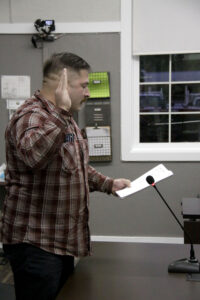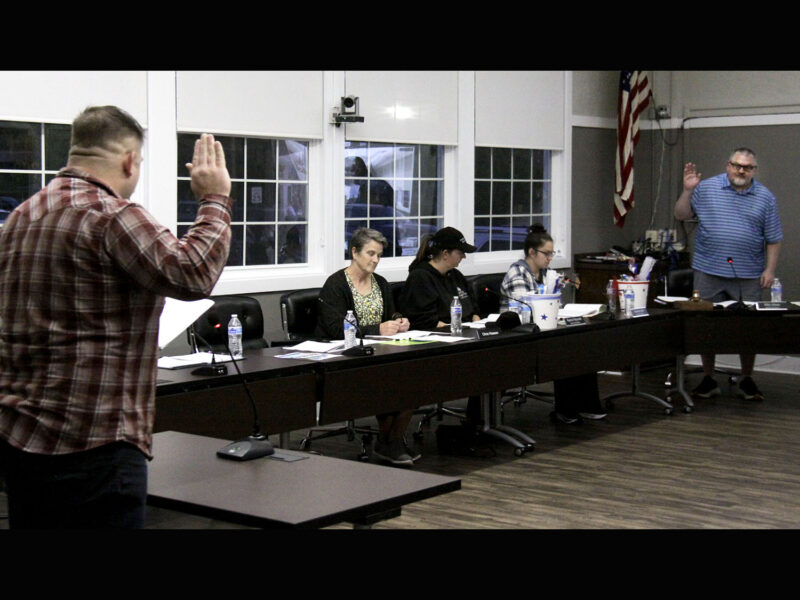Sweet Home School Board members at their Oct. 13 monthly meeting, unanimously approved the first reading of a revised draft of a policy, mandated by the governor, banning personal electronic device use by students during the school day.
Board members started the meeting, which covered a wide variety of topics and lasted close to three hours, by voting unanimously to appoint Cascadia resident Robert J. Webster, the only applicant for the Cascadia seat vacated when Floyd Neuschwander resigned at the Sept. 8 meeting.
Webster told board members he served in the U.S. Army and in the Oregon National Guard, where, according to his application, he developed “decades of leadership and team building.”
He has a first-grader, a sixth-grader and a high school senior attending schools in the district, he said.
Since there were no other applicants, board members limited their questions and Webster was sworn in quickly by Chair Mike Adams.
PED Policy
Supt. Terry Martin reviewed Gov. Tina Kotek’s July 2 executive order to prohibit student use of personal electronic devices from the beginning to the end of each school day, requiring school districts to adopt policies banning PED use by students by Oct. 31 and to fully implement those policies by Jan. 1, 2026.
Martin said he initially understood that the district would have “some leeway at the local level” and that the plan was to “talk it through, what would make sense for us” but “turns out we don’t – there’s exactly none.”
“The governor stated that from the start of the school day to the end of the school day, student cellphones are to be off, put away.”
He said that district administrators have agreed not to subject violators to “Phone Jail” and not to spend big money on phone pouches, as other districts have done.
“I subscribe to the philosophy from ‘Jurassic Park’: The kids will test the fences. They will figure it out.”
Currently, he said, district staff are not taking phones away from students, but “we don’t want to see them, we don’t want to hear them.”
“If an emergency happens, kids still have them,” he added. “I think that’s what parents want.”
Three exceptions to the policy are:
♦ Students who need phones per a medical provider’s order for the care and treatment of a medical condition, such as a blood sugar monitor or insulin pump for diabetics;
♦ Students on Individual Education Plans or 504 (accommodations for students with disabilities) Plans; and
♦ Written exemptions approved by district principals that do not fall under the two previous exceptions, such as students facing high levels of anxiety, which can be submitted via a Request for Personal Electronic Devices Exemption form available from the district.
Also, Martin noted, the policy allows parents and students to make provisions with school officials for “necessary communication” in unusual circumstances, such as a family emergency.
Also, the policy allows for use of cellphones for “academic activities and independent communications” such as apps necessary for completing class assignments.
Adams cited, as an example, math teacher Steve Thorpe’s Personal Finance students’ use of an app to do work in that class.
The policy also bans use of PEDs for “transferring or sharing of obscene, pornographic or otherwise illegal images or photographs” as well as “texting, sexting, emailing” content that “may constitute a crime.”
The draft policy lists sequential discipline, ranging up to possible expulsion, for noncompliance, but Martin said that “almost never” will a student be expelled for violating the cellphone ban.
“We’re not going to do suspensions over phones,” he said.
“This isn’t something that makes, I don’t think, anyone happy,” Martin added. “We know good will come out of it. We know that there’s a tremendous amount of folks not treating their peers very well electronically, so this takes away one more – they don’t have their phones out and available.”
He said schools are reporting increased conversation and, despite concerns that students might exit the high school campus to use their cellphones, numbers for breakfast and lunch are actually up.
Board members discussed whether they should do a first reading of the policy as a step toward meeting the Oct. 30 deadline, noting that there were portions of the draft in front of them that would need to be eliminated – district-provided pouches and state-suggested disciplinary measures such as detention and “Saturday School,” which Martin said should not be part of the district’s policy.
Martin said that because the directive was not passed by the Legislature last spring, the governor issued it as an executive order and the district has been waiting for “guidance” on timelines for implementing it. The state has not provided that guidance, he said.
He said a big concern is “loss of instructional time” for students who don’t comply, adding that the district “is going to be reasonable about it” and will avoid punishments that keep students out of classrooms.
Board Member Dustin Nichol asked whether individual building administrators could determine how to comply with the policy.
“Each building is unique and shouldn’t administrators and their staff come up with something if we give them guidelines – say, ‘Come up with a policy that best suits your building,’” he said. “Couldn’t they and their staff come up with something that fits their needs, instead of us trying to do something?”
He suggested that campuses could work out their own plan and bring those back to the board at its November meeting.
Board members discussed items they believed should be stricken from the policy, which largely were those mentioned earlier by Martin, then proceeded to a first reading of the policy.
Flag Policy Unchanged
Board members also voted 8-1, with member Mary Speck dissenting, not to revise the district’s flag policy, which had been proposed by Speck, who participated in the Oct. 13 meeting remotely.
Speck had proposed at the board’s Sept. 8 meeting that the policy be changed to require that a POW/MIA flag be flown “in the same manner” as the U.S. and Oregon flags already mentioned in the existing policy, “when required by state law.”
She also proposed that students be given an opportunity daily to recite the “Pledge of Allegiance” and that “appropriate”-sized U.S. flags, “manufactured in the United States, be properly displayed in each classroom” and that no other flags be displayed in classrooms.

She also suggested wording stating that the School Board “encourages district schools to give students opportunities to raise and lower the outdoor flags and to recite the Pledge or Allegiance over the loud speaker.
Certified union President Steve Thorpe, during his monthly report to the board, expressed concerns about the proposed flag policy, asking whether there had been any conversation with teachers or administrators to get their input.
“The people that it affects every day usually have really great input,” Thorpe noted, adding that he personally did not care where a flag was manufactured.
He pointed out that some grade school classes in the district recited the “Pledge of Allegiance every day,” adding, “You don’t have to eat apple pie every day to know how much you love it, and after a while it gets old.”
He also stated that every classroom in the district contains a flag “and every Monday we start it off with a “Pledge of Allegiance,” and either the pledge is recited or the national anthem is played at every school assembly and sporting event.
“You won’t see a single kid sit down or not honor their flag or their country,” he added.
“Man, if we’re going to do policies, I’d sure like to see it have to do with stuff that affects the safety and importance of our students and our teachers – parent policies, social media policies, things such as that.”
Things like staff turnover, he said, have “a little more importance than having a flag policy, adding that district schools honor the flag “very well.”
Martin told board members that Thorpe’s comments were “spot on.”
“What I heard Steve saying was that if it’s not broke, don’t fix it,” he said. “If you have first-graders and above and you ask them to recite the pledge for you, they can do so, which indicates to me that we’re on track with what we’re doing, with frequency that we’re doing flag salutes.
He also noted that OSBA and the district’s lawyers have indicated that there could be legal issues with the proposed changes, citing a case in which a judge ruled that an attempt to ban certain flags from classrooms in the Newberg school district was unconstitutional.
That case resulted in a $90,000 payout by the school district to a teacher who said the district retaliated against her for advocating for LGBTQ+ students.
“Once you start selecting what you will allow, you’re also selecting what you won’t allow,” Martin told board members. “That’s where all of the legal challenges come in.”
He added that he also agreed with Thorpe that “when we make changes we need to be talking to and reflecting on who the changes impact.
“This impacts our classroom teachers, time-wise, and all the other things that go along with it.”
Martin said he did not disagree with the “content” of the proposal, but said he was concerned about the position that approving it would put the district in.
Board Member Jenna Northern said she also was concerned about the impact on the schools that approving the policy changes could create, adding that she believed the amount of time currently allotted during a six-hour school day was adequate each week.
Member Rachel Maynard asked if a teacher would be allowed to hold flag salutes more frequently if desired and Martin said that they could and that some do.
Massey attempted to respond, but the audio in the board room did not allow her to speak.
Chair Mike Adams acknowledged Speck’s motion to submit the proposed changes for a first reading, but the motion died for lack of a second.
Member Dale Keene then moved and Northern seconded the motion to not change the policy.
Attendance and Enrollment
Martin reported that attendance in the month of September was “very strong.”
The high school reported 86.91% attendance; the junior high was 91.05%; the Charter School was 92.04%; Oak Heights was 92.13%; Holley 93.59%, which made it the winner for September; Hawthorne was close behind at 93.57%; and Foster was 92.11%.
Enrollment on Sept. 30 was 2,203, down from the same date in 2024 (2,264) and previous years.
“This still represents a decline over past years,” he said, noting that in 2023 the enrollment was 2,369 and in 2022 was 2,341.
Martin added that kindergarten enrollment is 129, and that those numbers go up, generally, as the grades go up, with 172 seniors in the district and 209 10th-graders.
“The trend is that we are graduating larger classes than what we are bringing in,” he said, which reflects state and national enrollment trends.
“As we do directly receive money for the students that are here, that’s something that we’ll talk about each time as we start our meeting. We’ll keep that out in front of you, because that’s where our overall operating budget comes from,” he told board members.
Board Member Rachel Maynard noted that the enrollment dropped “significantly” from 2,265 on the first day of school, Sept. 8, to 2,203 at the end of the month.
Martin responded that the Sept. 8 number included students who were enrolled at the end of last year, who the district anticipated would enroll.
“To start up the school year there’s a flurry of activity – folks that have moved. We do have a pretty large transiency rate, (people) moving between here and Lebanon, here and Albany, some out of state.
“It’s the start of the school year, settling in. Some people wait; once they see the school buses coming by, then it’s time to register.”
Despite the district’s efforts to make school “an enriching and engaging environment,” he said, some students simply do not attend and are dropped from enrollment after 10 days of absences and have to re-enroll in Sweet Home or elsewhere.
Strategic Plan Goals
Martin noted that the board had held a work session on the district’s Strategic Plan prior to its regular monthly meeting and “there are a few little tweaks that we need to make to this.”
Board members unanimously voted to put it on the November agenda for approval.
Martin listed the plan’s strategic priorities:
- Safe and Engaging Schools – Martin said this priority came out of community surveys and is “something that our community very strongly desires for our schools.” Thus, he said, the priority focuses on school safety and belonging, modernized classrooms and learning spaces, reduced “safety incidents and bullying and peer conflict referrals,” and climate surveys.
“On each of these, as the year goes on, I’ll be reporting on these,” he said
- Thriving Students and Prepared Citizens: Martin said this priority also “came out very high” from community members who want “students who are ready to take that next step, whether that’s going on to higher education, going on to trade school, whatever that may be for the individual student.”
- Academic Success for All: “We have to do that in all that we do,” Martin said. “We have to continue to work to eliminate the gaps in student learning. Whatever the percentage is, it may sound OK unless your find your own student on the wrong side of that percentage.”
He added that state-mandated goals for reading at the third grade, math at the eighth grade, early elementary attendance and on-track to graduate “are embedded in here.”
- Connected School Community: “Strengthening connections among schools, families and community partners to foster student growth and shared success.”
He said the board will need to approve the goals as part of the district’s strategic plan.
Board members also unanimously approved those goals.
New Phone System
Board members unanimously, with the exception of Speck, who had left the meeting, the purchase of a new phone system for the district for $176,922.50 from iPro.
Strong told the board that the existing system is breaking down – the voice mail function is currently not working.
The new system, he said, would be expected to last “well into the next decade or longer.
“It is not a Band-aid solution, it’s a good solution for us.”
Srong told board members that parts are no longer available for the district’s existing system, which was installed in 2003.
“We’re just to the place right now where we can’t get new parts for it, we have to get refurbished parts, and we’ve been buying parts and those haven’t been reliable,” he said.

In other action, the board:
♦ Following an executive session involving an appeal of a decision by Martin to trespass a parent from school property following an altercation on the high school campus, board members returned to open session and voted unanimously, with the exception of Speck, to uphold the decision.
♦ Unanimously approved, with the exception of Speck, the adoption of a high school health curriculum with an opt-out form that excuses students from learning about topics to which their families may object.
The board last year adopted curriculum from The Great Body Shop for K-6 and seventh- and eighth-grade students, but, Martin and district Director of Teaching and Learning Barbi Riggs told the board, the only option provided by the Oregon Department of Education for high-schoolers is LiveWell health curriculum. She said the district asked for a postponement in adopting a curriculum because “we wanted to be very transparent with you, the board, and with our community and our families.”
She said district officials wanted to come up with an opt-out form for families uncomfortable with the curriculum’s treatment of “some sensitive curriculum topics” in the sexual and reproductive health unit.
The “very transparent” form provides parents with the opportunity to opt students out of the entire unit or from specific topics outlined in the form. Students who opt out will do alternative study, she said.
♦ Approved an out-of-state trip for the high school cheer team to Anaheim from Feb. 18 through 25, 2026.
♦ Approved an out-of-state field trip for two student representatives of the high school’s TRIO Upward Bound program to to attend the Upward Bound Science, Technology, Engineering, Arts and Mathematics Symposium in Orlando, Fla., Nov. 5-9.
♦ Heard a state-required report from Riggs on the district’s compliance with nearly 60 state standards pertaining to student learning experience, “aligned and focused educational systems,” engagement with the community, safe and inclusive schools, and “committed and supportive staff.”
She said that the district is in compliance this year with every standard.
♦ Heard a report from student Cannon Klumpf on the high school’s Homecoming Week, its Your First My Last event in which graduating seniors presented keychains to district kindergarteners bearing the number 2037, the year those kindergartners are expected to graduate.
Blood drive (52 units from 63 total donors) and announced the high school’s upcoming canned food drive, and an anti-bullying campaign being conducted by the high school’s Class Board students.
♦ Heard from Business Manager Kevin Strong that, one quarter of the way through the fiscal year, the district has spent $4,896,291 of General Fund dollars, an increase of $342,260, which Strong attributed to higher personnel costs and increased insurance expenses.
He added that, as Martin had said earlier, “our revenue is directly tied to enrollment” and so district officials need to pay attention to enrollment numbers.
“Currently, at the elementary level, we probably have some of the most favorable staff-student ratios that we’ve had in decades,” he told the board. “But keep in mind that, for the long term, we need to be careful there just because our revenue from the state is driven by our enrollment.”
Self-Reliance Encouraged
The board also heard from Gary Jarvis, who told members that in his years as a resident in Sweet Home he was “generally very pleased” with the level of respect between board members, administration, and various employee organizations.
He criticized the conduct and order of recent meetings, including the singling out of a member of the public at the last board meeting.
He encouraged board members to familiarize themselves with Robert’s Rules of Order, noting that some board actions have veered from those principles of meeting conduct and order, which emphasize fairness, focus and efficient, effective decision-making.
Jarvis, who said he was speaking from long experience in employee union activities, noted that “the notion of everybody working together for a common goal got off to a kind of rocky start with this newest composition of the School Board.”
“I know from long experience that it can be difficult to truly put aside divisions, but I applaud this group for attempting to put this episode of the last couple of months behind you and move forward to important business before you this year,” he said.
“It’s important to the students, staff and teachers, as well as to the community.”
He urged board members to “rely on yourself and your own best judgment” when addressing union negotiations and issues involving students and staff.
“Unity between you is very important.”
Jarvis also acknowledged that while organizations such as the Oregon School Boards Association and Oregon Education Association can be good resources, “but ultimately we will all do better when we make our own decisions and use their assistance only when necessary” when formulating policy for staff and students.
“Both the OEA and the OSBA often may have their own agendas that don’t necessarily mesh with or benefit the community or students of Sweet Home,” he said.
Jarvis added that, when he had children in school some 30 years ago, the OSBA “appeared to use the local school district in Elmira, in which his family then lived, as a “test case in gutting just-cause protections in teachers’ contracts.”
“The OSBA encouraged this so that, if successful, it could be used as a template for pattern bargaining in larger districts. The resulting lockout of teachers, in ordering them to turn in their keys and clear out their classrooms over the impasse, split the community and hurt the students, parents and teachers alike, and diminished trust and support of the School Board.”
He added that, like the Fern Ridge district, “Sweet Home is a unique community with some unique needs, so it is in all of our best interests to tailor our contracts and policies to our local needs.”
He said Sweet Home’s School Board and teachers have, in recent years, “done precisely this and I hope it continues.”





